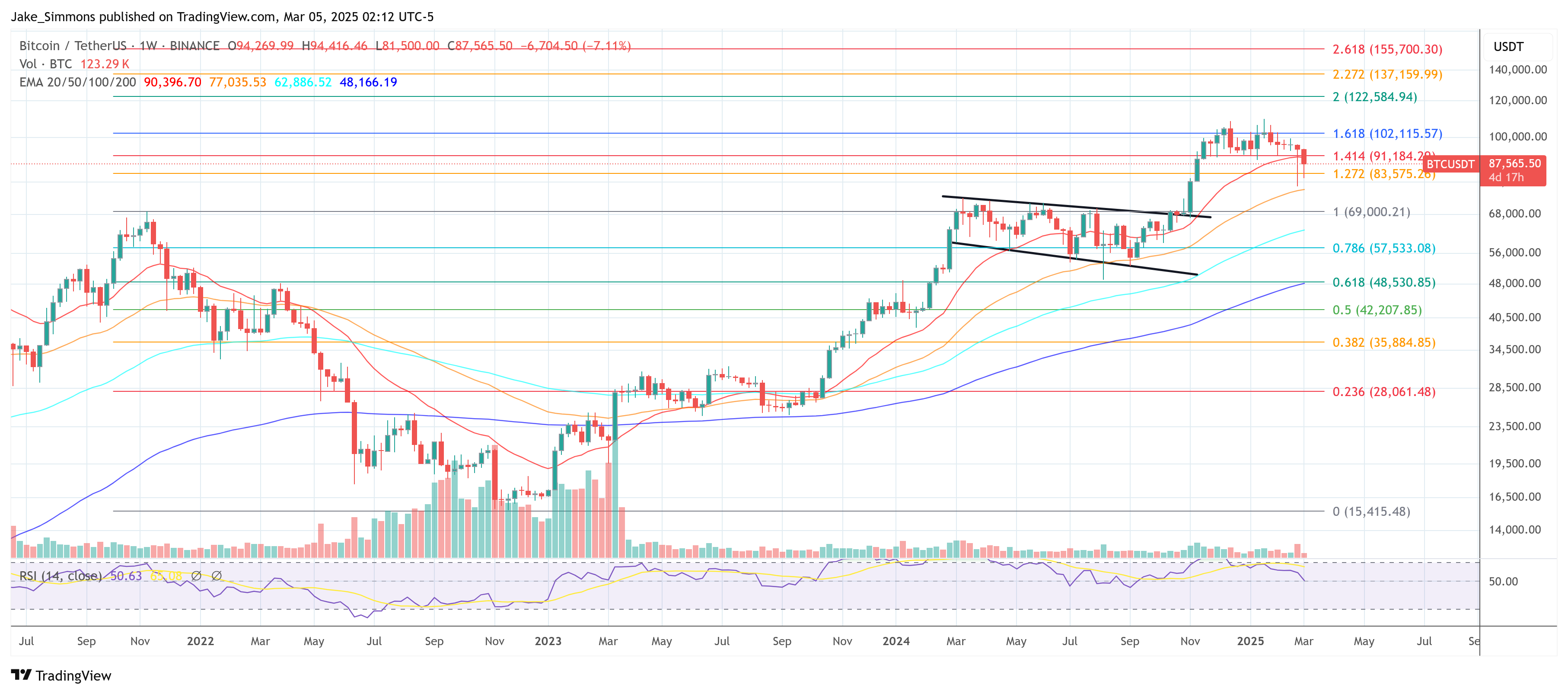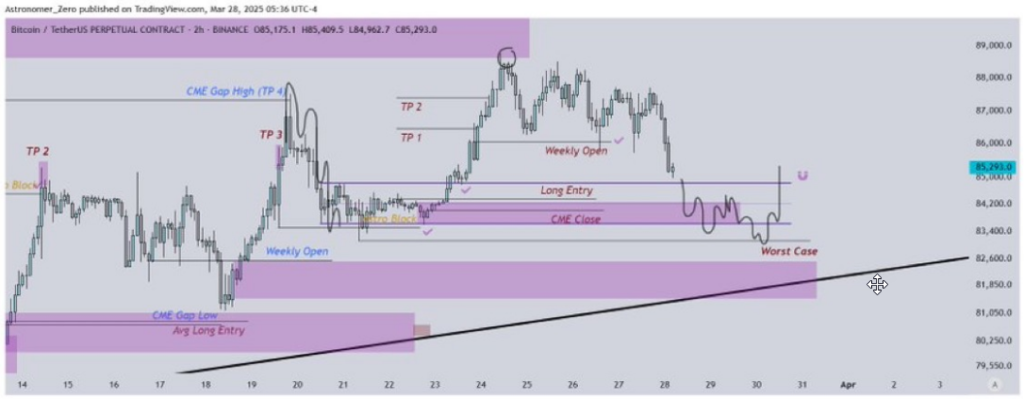Bitcoin
Crypto Markets Are Misreading Trump’s Strategic Reserve: Bitwise
Published
4 weeks agoon
By
admin
The crypto markets have whipsawed following President Donald Trump’s unexpected announcement of a strategic crypto reserve over the weekend. Bitwise Asset Management’s Chief Investment Officer (CIO), Matt Hougan, contends that traders are overreacting to the proposed plan’s details and missing what could be a bullish development for digital assets.
Late Sunday, President Trump revealed a United States government initiative to acquire and hold five different cryptocurrencies—Bitcoin, Ethereum, Solana, XRP, and Cardano—in a strategic reserve. Initially, the market response was emphatically positive: Bitcoin’s price surged from around $85,000 to $95,000. However, as Hougan notes in his latest investor memo, that initial optimism was short-lived. By Monday, the major crypto assets named in the announcement had surrendered their gains.
Everyone Is Misjudging Trump’s Crypto Reserve
Bitwise released its memo on March 4, titled “The Market Has This Wrong: Thoughts on Trump’s Strategic Crypto Reserve.” In it, Hougan points to overly narrow market interpretations as the principal cause behind the abrupt retracement. “The market is overthinking things. For all the flaws in the rollout, the reserve news is bullish.”
Related Reading
He elaborates on why the proposal is not being greeted with lasting enthusiasm. A large part of the skepticism centers on the White House’s choice of five cryptocurrencies, which critics describe as an overly broad selection. In Hougan’s words: “The inclusion of speculative assets like Cardano feels more calculating than strategic.”
Although the plan initially seemed like a vote of confidence from Washington, some crypto commentators—such as Coinbase CEO Brian Armstrong and Castle Island Ventures Founder Nic Carter—have questioned the rationale behind broadening the reserve beyond Bitcoin. Bitwise CEO Hunter Horsley also weighed in shortly after the announcement, publicly expressing a preference for a more conservative, bitcoin-centric reserve.
Despite this, Hougan’s memo argues that market participants may be failing to see the bigger picture. In the memo, Hougan outlines three major takeaways regarding the strategic reserve plan.
Hougan suggests that President Trump’s first public draft often differs considerably from what eventually becomes policy. The reserve, he argues, might ultimately shift to a “bitcoin-only” approach or evolve to a more balanced composition following industry input. “Over the coming days, big names from the crypto industry will make their feelings felt about the reserve idea.”
According to Hougan, the announcement further cements the perception of Bitcoin as a strategically important asset. He believes this could spur competing nations to follow suit, mirroring smaller-scale adoption already seen in El Salvador, Bhutan, and Abu Dhabi. “If you are Honduras, Mexico, or Guatemala, and you’re watching El Salvador and now the US acquire bitcoin, can you really afford to be at zero?”
Related Reading
Hougan also points to the political calculus, suggesting that even a future administration with different views might not divest the reserve once it exists. He notes that the US has historically held onto strategic assets, such as gold, for extended periods. “We learned this in the last election, where the GOP’s courtship of crypto gained it many votes while Democratic hostility gained few. I suspect that any crypto that is purchased will be held for a very long time.”
Despite the optimism, Hougan acknowledges the prospect that the pushback could become so intense that the reserve is either scaled down or scrapped. Critics say that including less-established assets alongside Bitcoin only muddies the waters and may undermine the legitimacy of the initiative. Hougan, however, believes that “the final reserve will be nearly entirely bitcoin, and it will be larger than people think.”
He also underscores a broader point: The simple acknowledgment by the US government that crypto assets can be deemed “strategic” has potentially game-changing significance. In his view, such a designation could catalyze global adoption, spurring other countries to purchase crypto or ramp up holdings already in place.
According to Hougan, Sunday’s announcement should be interpreted as bullish for digital assets—despite the complicated rollout and the resulting price swings. He warns that markets might be letting short-term controversies overshadow the bigger picture: “The US government declaring crypto assets ‘strategic’ is bullish. I think the market will eventually realize that.”
As the White House prepares for a scheduled Crypto Summit this Friday—hosted by crypto czar David Sacks—industry voices will likely press for a more measured and possibly narrower reserve structure. Whether the final policy ultimately narrows to a bitcoin-focused plan or persists with multiple coins, Hougan believes it may still mark a meaningful step forward in the mainstream legitimization of crypto. The initial reaction may have been mixed, but, as he succinctly puts it, “after the dust settles, I suspect the final reserve will look pretty good.”
At press time, BTC traded at $87,565.

Featured image from YouTube, chart from TradingView.com
Source link
You may like


Bitcoin CME Gap Close About To Happen With Push Toward $83k


Listing an altcoin traps exchanges on ‘forever hamster wheel’ — River CEO


Nasdaq Files To Launch a New Grayscale Avalanche (AVAX) Exchange-Traded Fund


How To Measure The Success Of A Bitcoin Treasury Company


Why ‘Tiger King’ Joe Exotic Launched a Solana Meme Coin From Behind Bars


Trump pardons BitMEX, is ‘Bitcoin Jesus’ Roger Ver next?
Bitcoin
Bitcoin CME Gap Close About To Happen With Push Toward $83k
Published
58 seconds agoon
March 30, 2025By
admin
Reason to trust

Strict editorial policy that focuses on accuracy, relevance, and impartiality
Created by industry experts and meticulously reviewed
The highest standards in reporting and publishing
Strict editorial policy that focuses on accuracy, relevance, and impartiality
Morbi pretium leo et nisl aliquam mollis. Quisque arcu lorem, ultricies quis pellentesque nec, ullamcorper eu odio.
Bitcoin (BTC) is steadily approaching the highly anticipated Chicago Mercantile Exchange (CME) gap close, with price action aligning with analyst’s expectations of a move toward $83,000. As Bitcoin corrects from recent highs, a crypto analyst expects a rebound to come next. However, if key support fails, the possibility of further downside remains.
Bitcoin To Drop To CME Gap Close
Bitcoin has been on a rollercoaster this year, skyrocketing to new ATHs and experiencing major price breakdowns that pushed it to new lows. Recently the cryptocurrency saw a surge toward $89,000 but faced a rejection. Now the top crypto is pulling back again, with crypto analyst Astronomer on X (formerly Twitter) pinpointing the $83,000 – $84,000 low range as its next critical support level.
Related Reading
This crucial support zone in the price chart aligns with the CME gap close, a common phenomenon in the BTC Futures market. BTC revisits price gaps left when the CME price closes over the weekend and opens on Sundays.

Astronomer has outlined his long-term trading plan for Bitcoin, expecting the cryptocurrency to consolidate around the support level before bouncing. He believes that the CME gap close is a significant technical development that could determine Bitcoin’s price movements.
Supporting the expectations of a short-term pullback, historically, a bearish close on Friday often leads to red Mondays or Tuesdays for Bitcoin. Moreover, the analyst highlights that the market is still in the pre-New York Open (NYO) phase, leaving room for an intraday reversal.
However, he anticipates a late-night drop during the NYO trading session due to the lack of liquidations and untested support levels. He also mentions that combined with these factors, Bitcoin’s recent pullback from $89,000 is a strong indication that its price may not be bullish locally.
Based on his Bitcoin price chart, Astronomer considers the $81,400 – $82,400 range the worst-case support zone. Bitcoin is expected to revisit this target zone before any attempt at a potential reversal.
Can Bitcoin Rebound? Take Profit Levels To Watch
While Bitcoin’s short-term price action appears bearish, its macro trend remains somewhat stable, according to Astronomer’s analysis. The analyst has marked a “long entry” zone in the chart, suggesting that the $83,000 – $84,000 zone was a potential buying opportunity if Bitcoin finds support there.
Related Reading
The analyst predicts that if Bitcoin can successfully hold the CME gap close, a bounce toward the weekly open price at $86,000 could be its first step toward a much-anticipated recovery. Beyond this, the analyst has pinpointed key take profit levels marked from TP1 – TP4 on the price chart. These levels suggest that Bitcoin could surge higher to reach a target of $87,000 – $88,000.
However, a break below the worst-case support zone could trigger a bearish shift in sentiment, potentially leading to a deeper price correction for Bitcoin.
Featured image from Gemini Imagen, chart from TradingView
Source link
Bitcoin
How To Measure The Success Of A Bitcoin Treasury Company
Published
2 hours agoon
March 30, 2025By
admin
In the world of traditional finance, evaluating a company’s success usually means tracking revenue growth, earnings per share, or return on equity. But what happens when the core of a company’s strategy isn’t selling products or services, but accumulating Bitcoin?
That’s the question facing a new class of Bitcoin treasury companies. These are publicly traded firms whose central mission is to acquire and hold Bitcoin over the long term. And to understand whether they’re succeeding, we need a fresh set of tools.
This article introduces those tools—new key performance indicators (KPIs) designed to evaluate how well a company is executing its Bitcoin strategy. Many of these indicators have been pioneered by Michael Saylor and his company, Strategy, where they can be seen implemented on their new dashboard. These new metrics may sound complex at first, but once broken down, they offer powerful insight into whether a Bitcoin treasury company is truly delivering for its shareholders.
1. BTC Yield: Measuring Accretion, Not Earnings
What it is: BTC Yield tracks the percentage change over time in the ratio between a company’s Bitcoin holdings and its fully diluted share count. In simple terms: how much more Bitcoin is owned per potential share of stock.
Why it matters: This KPI is designed to answer a unique question: Is the company acquiring Bitcoin in a way that benefits shareholders?
Let’s say a company holds 10,000 BTC and has 100 million diluted shares. That’s 0.1 BTC per share. If, a year later, it holds 12,000 BTC and has 105 million shares, it now holds ~0.114 BTC per share—a 14% increase. That 14% is your BTC Yield.
What makes it unique: BTC Yield doesn’t care about profit margins or EBITDA. It’s focused on how effectively the company is increasing Bitcoin ownership relative to the number of shares that could exist. This is key in a strategy that involves using equity to buy BTC. If management is printing new shares to buy Bitcoin, shareholders want to know: is the Bitcoin per share going up or down?
How to use it: Investors can track BTC Yield over time to see if dilution (more shares) is being offset by accretive Bitcoin purchases (more BTC). A consistently rising BTC Yield suggests management is executing well.
2. BTC Gain: The Bitcoin-Based Growth Metric
What it is: BTC Gain takes the BTC Yield and applies it to the company’s starting Bitcoin balance for a period. It tells you how many theoretical “extra” bitcoins the company effectively added through accretive behavior.
Why it matters: This is a way of visualizing BTC Yield not as a percentage, but as Bitcoin itself. If BTC Yield for the quarter is 5% and the company started with 10,000 BTC, BTC Gain is 500 BTC.
What makes it unique: It helps you think in Bitcoin terms, which aligns with the company’s long-term goal. Shareholders aren’t just watching for more BTC—they want more BTC per share. BTC Gain helps quantify how much more BTC the company would’ve had if it started from scratch and grew holdings accretively.
How to use it: BTC Gain is especially helpful when comparing different time periods. If one quarter shows 200 BTC Gain and the next shows 800 BTC Gain, you know the company’s Bitcoin strategy had a much stronger impact in the second period—even if the BTC price stayed flat.
3. BTC $ Gain: Bringing Bitcoin Gains Into Dollar Terms
What it is: BTC $ Gain translates BTC Gain into U.S. dollars by multiplying it by the price of Bitcoin at the end of the period.
Why it matters: Investors still live in a world dominated by fiat. Converting Bitcoin-based growth into dollar terms helps bridge the communication gap between Bitcoin-native strategy and traditional shareholder expectations.
What makes it unique: This metric offers a hybrid lens—Bitcoin-denominated growth, viewed in fiat terms. But here’s the catch: BTC $ Gain can show a positive number even if the actual value of the company’s holdings dropped (because the metric is based on share-adjusted accumulation, not fair market value accounting).
How to use it: Use this metric to contextualize how much value (in dollars) the company’s Bitcoin acquisition strategy may have created over a period—just remember that it’s not a profit measure. It’s a reflection of growth in stake, not accounting gain or loss.
4. Bitcoin NAV: A Snapshot of Raw Bitcoin Holdings
What it is: Bitcoin NAV (Net Asset Value) is the market value of the company’s Bitcoin holdings. It’s calculated simply: Bitcoin Price × Bitcoin Count.
Why it matters: It gives a snapshot of the company’s Bitcoin “war chest,” plain and simple.
What makes it unique: Unlike traditional NAV used in mutual funds or ETFs, this version ignores liabilities like debt or preferred stock. It’s not meant to tell you what shareholders would get in a liquidation. Instead, it’s just: How much Bitcoin does the company own, and what is it worth right now?
How to use it: Use Bitcoin NAV to understand the scale of the company’s Bitcoin strategy. A rising NAV could reflect more Bitcoin, higher prices, or both. But remember: it’s not adjusted for debt or financial obligations, so it’s not a full picture of shareholder value.
5. BTC Rating: The Leverage Check You Don’t Have to Guess About
What it is: BTC Rating is a simple ratio: the market value of the company’s Bitcoin divided by its total financial obligations. It shows how much of the company’s debt and liabilities could be covered by its Bitcoin holdings.
Why it matters: This metric gives a Bitcoin-native snapshot of balance sheet strength. It helps investors quickly gauge whether a company’s Bitcoin strategy is supported by a sound capital structure—or weighed down by obligations.
What makes it unique: Unlike traditional credit ratings that rely on opaque models and institutional trust, BTC Rating is transparent and verifiable. The inputs—Bitcoin holdings and liabilities—are public. It puts solvency into plain sight, without needing anyone’s permission or opinion.
How to use it: A BTC Rating above 1.0 suggests the company’s Bitcoin position outweighs its obligations—a strong indicator of strategic flexibility and solvency. A rating below 1.0 may signal over-leverage or exposure to refinancing risk. Watching how this ratio evolves over time gives investors a powerful lens for evaluating whether the company’s Bitcoin-first strategy is being executed responsibly.
Why These Metrics Matter Together
Each KPI gives a different lens:
- BTC Yield shows shareholder-accretive growth.
- BTC Gain translates that into BTC terms.
- BTC $ Gain puts it in dollars.
- Bitcoin NAV shows raw Bitcoin value.
- BTC Rating tests how that value stacks up against liabilities.
Used together, they give investors a comprehensive picture of whether a Bitcoin treasury company is:
- Growing its stake effectively
- Protecting or enhancing shareholder value
- Managing risk appropriately
One Final Note: These Metrics Aren’t Perfect
These KPIs are not traditional financial metrics, and they aren’t meant to be. They ignore things like operating revenue, cash flow, or even debt service costs. They also assume that convertible debt will convert, not mature.
In other words, they’re tools designed to isolate the Bitcoin strategy, not the whole business. That’s why they should be used alongside a company’s financial statements—not as a substitute.
But for investors trying to understand whether a company is making smart moves in the Bitcoin arena, these metrics offer something traditional tools can’t: clarity on whether management is using equity and capital in a way that actually grows Bitcoin per share.
And in a Bitcoin-first world, that just might be the most important metric of all.
Disclaimer: This content was written on behalf of Bitcoin For Corporations. This article is intended solely for informational purposes and should not be interpreted as an invitation or solicitation to acquire, purchase, or subscribe for securities.
Source link
Bitcoin
Trump pardons BitMEX, is ‘Bitcoin Jesus’ Roger Ver next?
Published
4 hours agoon
March 30, 2025By
admin

Vitalik Buterin, Ross Ulbricht, and Tucker Carlson are among those urging President Donald Trump to pardon Roger Ver, aka Bitcoin Jesus.
Known as Bitcoin Jesus for his early advocacy of Bitcoin, Ver faces up to 109 years in prison on tax charges, including allegations of evading $48 million in taxes. Despite renouncing his U.S. citizenship in 2014 to avoid prosecution, Ver’s legal troubles resurfaced when he was arrested in Spain in 2024. But following the president’s earlier pardons of figures like Ulbricht and BitMEX co-founders, observers wonder whether Ver’s would catch a break. Is a pardon on the way, or will Ver’s legal troubles continue?
Read on for a closer look.
Crypto cronies
After Trump embraced cryptocurrency, many crypto leaders rallied to support him by donating funds to his inauguration and hobnobbing at galas.
Trump also , which industry brass celebrated.
In return, Trump signed an order to stockpile tokens and swiftly acted in favor of the industry. Under Trump-appointed SEC chair Mark Uyeda, investigations into several cryptocurrency companies, including Immutable, Crypto.com, Ripple, and Coinbase, were dismissed.
In a notable move on Thursday, March 27, Trump pardoned BitMEX co-founders Arthur Hayes, Benjamin Delo, and Samuel Reed, who had pleaded guilty to federal charges related to money laundering and regulatory violations. The trio was convicted for failing to implement anti-money laundering measures at BitMEX, which prosecutors had labeled a “money laundering platform.” Reed had also violated the Bank Secrecy Act and paid a $10 million fine. But under Trump, it seems all is forgiven.
This has sparked speculation on whether Ver, a prominent figure in the crypto world, could also receive the same courtesy.
Ver, a Silicon Valley native with a libertarian streak, was deeply involved in the early days of cryptocurrency, investing in companies like Kraken, Ripple, and Blockchain.com. In 2017, Ver hyped Bitcoin Cash (BCH) as more suitable for everyday payments.
Roger Ver was there for me when I was down and needed help. Now Roger needs our support.
No one should spend the rest of their life in prison over taxes. Let him pay the tax (if any) and be done with it. #FreeRoger pic.twitter.com/flP573hm0N
— Ross Ulbricht (@RealRossU) February 20, 2025
Ver’s past
In 2000, by the age of 20, Ver began to participate in libertarian party debates.
During these debates, he made critical statements about the agents of the Bureau of Alcohol, Tobacco, and Firearms, calling them “murderers” and referencing their involvement in the scandalous Waco Siege in which dozens of children were killed in a standoff between FBI and ATF agents and Branch Davidian cult followers. Ver didn’t know that ATF agents were present during these debates.
In the 2000s, Ver became involved in e-commerce. On top of tech enterprises, Ver was selling firecrackers on eBay. After selling unlicensed firecrackers in 2001, he was charged and spent 10 months in prison. The fact that he was locked in jail instead of being fined or notified about the necessity of obtaining a license led Ver to think that the case was politically motivated and that his criticism of ATF was the real reason behind his prosecution. Without fear of further persecution, Ver left the U.S. after his post-prison probation ended.
By 2011, Ver learned about Bitcoin and became one of its first investors. He also advocated for Bitcoin long before it went mainstream, with multi-million investments and national leaders talking about its importance for the future of their countries.
The key points of Ver’s advocacy for Bitcoin were the financial freedom of individuals and the stopping of government and banks from interfering in people’s lives.
The legal fight
Since February 2014, Ver has been a citizen of Saint Kitts and Nevis. He claims that he had to renounce his U.S. citizenship after long-lasting targeting from the U.S. government.
In April 2024, he was indicted and arrested in Spain on charges of U.S. tax evasion and mail fraud. Ver is accused of dodging $48 million in taxes after earning up to half a billion dollars through cryptocurrencies.
According to prosecutors, Ver failed to pay his “exit tax” on 131,000 BTC owned by his two companies when he left the U.S. and provided false info to the law firms filing Ver’s tax returns. Allegedly, he sold his bitcoins in 2017 without notifying the financial attorneys.
Ver clarifies that three charges of mail fraud (combined, punishable by 19 years behind bars) are based on the three letters with his tax returns he sent to the Internal Revenue Service (IRS).
Ver denies he committed crimes such as tax evasion and mail fraud. He insists he was doing his best to comply with the nascent Bitcoin taxation rules, and that his prosecution was politically motivated.
In December, he began his legal fight against the prosecution, denying all the charges. He filed a motion to dismiss charges, but the government rejected it in January.
Ver’s legal team challenged an exit tax as “an unconstitutional burden on the fundamental right to expatriate.” For people like Ver, who have substantial amounts of low-liquidity assets, the exit tax may be prohibitive. The government suggests Ver is a fugitive. He disagrees with this status as he doesn’t hide and didn’t commit crimes for which he is judged while living in the U.S.
On March 1, Ethereum’s Buterin published an X post arguing that the exit tax doesn’t exist in most other countries and called it the “tax-by-citizenship” and “extreme.”
In addition, Buterin mentioned that the IRS obtained some of the information by intimidating Ver’s lawyers. The Ethereum founder added:
“Genuine good faith mistakes should be treated by giving the actor the opportunity to pay back taxes if needed with interest and penalties, not with prosecution.”
Going to prison for the rest of your life over non-violent tax offenses is absurd. The case against Roger seems very politically motivated; like with @RealRossU, there have been plenty of people and corporations who have been accused of far worse and yet faced sentences far… https://t.co/7G3zDkn2F2
— vitalik.eth (@VitalikButerin) March 1, 2025
Will Bitcoin Jesus be pardoned?
Trump promised to pardon Ross Ulbricht if get elected. Ulbricht, the man behind the Silk Road marketplace charged for money laundering and drug trafficking, is an important figure in the history of Bitcoin as his marketplace drove Bitcoin’s adoption. After the inauguration, Trump indeed pardoned Ulbricht to much acclaim.
Soon, various crypto advocates began to urge Trump to pardon Roger Ver. On Jan. 21, 2025, following the pardon of Ross Ulbricht, an X influencer using the moniker Rothmus published a short post calling for the pardon of Ver to which Elon Musk replied: “will inquire.” This reply gave the community hope for the pardon of Bitcoin Jesus.
https://twitter.com/Rothmus/status/1881536312710402268
On March 17, Marla Maples, Trump’s ex-wife, took to X to share a touching video where people who met Ver tell their stories of his generosity.
It is not clear, though, if the POTUS paid attention to this post.
The hope for a pardon of Ver was seriously undermined on Jan. 26, when Elon Musk suddenly, via an X post, stated that Ver would not be pardoned because he gave up his U.S. citizenship.
Roger Ver gave up his US citizenship. No pardon for Ver. Membership has its privileges.
— Elon Musk (@elonmusk) January 26, 2025
The statement drew much criticism, as Musk is not an elected official and cannot decide who to pardon and who not to. He is, however, Trump’s advisor and was a major donor to his “MAGA” campaign.
More than that, the POTUS is not prohibited from pardoning non-U.S. citizens. Finally, many commented that Ver had to renounce his citizenship under pressure from ATF and a U.S. prison sentence.
I missed this tweet.
Another time I will publicly criticize Elon, hopefully for his own benefit. Because this is a terrible and wildly ignorant “hot take”.
1) You don’t need to be a citizen to get a pardon.
2) Ver was a citizen and specifically renounced his U.S. citizenship in…— Viva Frei (@thevivafrei) January 27, 2025
A few hours after Musk’s tweet, Ver took X to post a video in which he briefly explained why he was prosecuted and asked Trump for a pardon.
In the video, Ver stated that he is American and that renouncing his citizenship was one of the “hardest and saddest decisions [he] ever made.”
After Ulbricht, Hayes, Delo, and Reed received presidential pardons, others, including Angela McArdle, who currently serves as Chair of the national Libertarian Party, called for freeing Ver as well.
“Let’s pray Roger Ver is next!” she declared on Friday.
It remains to be seen whether Musk made skeptical comments over the possibility of Ver’s clemency on Trump’s behalf or if it was only his view of the situation.
At last check Saturday, Trump hasn’t commented on Ver’s situation.
Source link

Bitcoin CME Gap Close About To Happen With Push Toward $83k

Listing an altcoin traps exchanges on ‘forever hamster wheel’ — River CEO

Nasdaq Files To Launch a New Grayscale Avalanche (AVAX) Exchange-Traded Fund

How To Measure The Success Of A Bitcoin Treasury Company

Why ‘Tiger King’ Joe Exotic Launched a Solana Meme Coin From Behind Bars

Trump pardons BitMEX, is ‘Bitcoin Jesus’ Roger Ver next?

Terraform Labs to Open Claims Portal for Investors on March 31

BitGo CEO Calls For Regulation Amid Galaxy Digital’s Settlement

Ethereum Bulls Disappointed As Recovery Attempt Fails At $2,160 Resistance

US recession 40% likely in 2025, what it means for crypto — Analyst

Crypto Investment Firm Galaxy Digital Settles With New York AG for $200,000,000 Over Luna Allegations

Bitcoin Covenants: CHECKTEMPLATEVERIFY (BIP 119)

This Week in Bitcoin: GameStop Reveals Reserve, But Inflation Fears Rear Their Head

Solana price prepares a wild ride as risks rise

FTX to Begin $11.4B Creditor Payouts in May After Years-Long Bankruptcy Battle

Arthur Hayes, Murad’s Prediction For Meme Coins, AI & DeFi Coins For 2025

Expert Sees Bitcoin Dipping To $50K While Bullish Signs Persist

Aptos Leverages Chainlink To Enhance Scalability and Data Access

Bitcoin Could Rally to $80,000 on the Eve of US Elections

Sonic Now ‘Golden Standard’ of Layer-2s After Scaling Transactions to 16,000+ per Second, Says Andre Cronje

Institutional Investors Go All In on Crypto as 57% Plan to Boost Allocations as Bull Run Heats Up, Sygnum Survey Reveals

Crypto’s Big Trump Gamble Is Risky

Ripple-SEC Case Ends, But These 3 Rivals Could Jump 500x

Has The Bitcoin Price Already Peaked?

A16z-backed Espresso announces mainnet launch of core product

Xmas Altcoin Rally Insights by BNM Agent I

Blockchain groups challenge new broker reporting rule

The Future of Bitcoin: Scaling, Institutional Adoption, and Strategic Reserves with Rich Rines

Trump’s Coin Is About As Revolutionary As OneCoin

Is $200,000 a Realistic Bitcoin Price Target for This Cycle?
Trending

 24/7 Cryptocurrency News5 months ago
24/7 Cryptocurrency News5 months agoArthur Hayes, Murad’s Prediction For Meme Coins, AI & DeFi Coins For 2025

 Bitcoin2 months ago
Bitcoin2 months agoExpert Sees Bitcoin Dipping To $50K While Bullish Signs Persist

 24/7 Cryptocurrency News3 months ago
24/7 Cryptocurrency News3 months agoAptos Leverages Chainlink To Enhance Scalability and Data Access

 Bitcoin5 months ago
Bitcoin5 months agoBitcoin Could Rally to $80,000 on the Eve of US Elections

 Altcoins2 months ago
Altcoins2 months agoSonic Now ‘Golden Standard’ of Layer-2s After Scaling Transactions to 16,000+ per Second, Says Andre Cronje

 Bitcoin5 months ago
Bitcoin5 months agoInstitutional Investors Go All In on Crypto as 57% Plan to Boost Allocations as Bull Run Heats Up, Sygnum Survey Reveals

 Opinion5 months ago
Opinion5 months agoCrypto’s Big Trump Gamble Is Risky

 Price analysis5 months ago
Price analysis5 months agoRipple-SEC Case Ends, But These 3 Rivals Could Jump 500x


